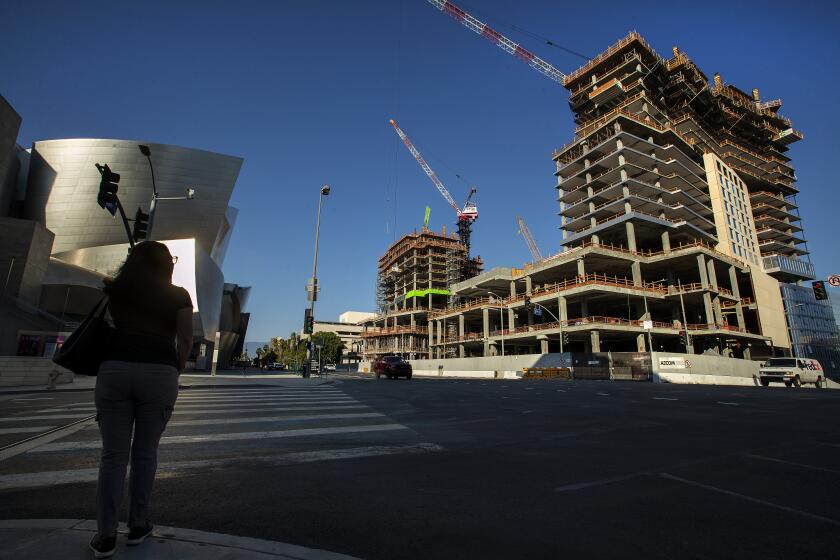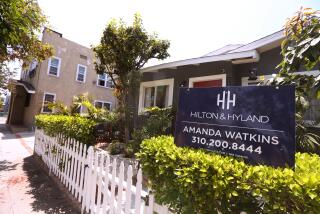L.A. office leasing feels the COVID effect

- Share via
The impact of COVID-19 reverberated through the Los Angeles County office market in the third quarter as many businesses kept employees at home and managers put off decisions about their future space needs.
Office occupancy fell by 2.7 million square feet, a worsening of conditions in the second quarter when occupancy fell by 1.9 million square feet, real estate brokerage CBRE said.
The weak third-quarter leasing was roughly in line with the drop in occupancy seen in early 2009, the worst quarter for the market in the Great Recession. Overall vacancy climbed to 15% in the third quarter, up from 13.7% in the previous quarter and 12.6% in the same period a year earlier.
“Leasing activity is well below pre-COVID levels,” CBRE broker Todd Doney said. “A big majority of deals getting done are short-term lease renewals, sort of kicking the can down the road.”
The market has also seen a burst of sublease space offered by tenants looking for some income by renting out space they’re paying for but not using, a common occurrence in a struggling economy. About 2 million square feet of sublease space has hit the L.A. market since the pandemic started, Doney said.
“It’s a lot of space, but not that much of the overall market” of 220 million square feet, he said. Rentable sublease space is spread among more than 740 locations and much of it is available for only short periods, which typically doesn’t appeal to businesses looking to set up a permanent address.
So although that’s the highest amount of sublease space on the market in years, “there’s not really a great amount of concern” yet among landlords that it will compete with their space on the market, Doney said. “It’s hard to get rid of short-term sublease space.”
The market is nevertheless challenging for landlords. A growing number of companies, including high-profile businesses such as Google and Warner Music Group, have announced that they will keep their employees working from home until at least next year, which suggests demand for new space will continue to be low as the world waits for a vaccine and new treatments that will defang the novel coronavirus.
In a downtown missing its office workers, tourists and museum visitors, work on the Frank Gehry-designed $1-billion Grand complex reaches the halfway point.
An exception to diminishing demand came from entertainment streaming giant Netflix Inc., which has expanded in recent years to become Hollywood’s largest office tenant.
Most company employees are still working from home, but in September Netflix signed a lease for 171,000 square feet in Burbank to set up an animation studio. It was the biggest lease of the year in the Los Angeles market, according to real estate data provider CoStar.
Netflix co-Chief Executive Reed Hastings is among leaders of some big U.S. companies that are champing at the bit to get their teams back working together in their offices, telling the Wall Street Journal recently that he does not see “any positives” to working from home.
Landlords have been loathe to lower their rents, even in the face of weakening demand. Asking rates for Class A space in Los Angeles County climbed to $3.97 a square foot per month from $3.88 in the previous quarter and $3.71 in the third quarter of last year.
While holding the line on rents, however, landlords have had to give ground on incentives they offer to tenants to sign deals, such as bigger allowances to build out their offices or periods of free rent.
“Landlords are starting to get aggressive” on concessions to tenants, Doney said.
One tenant well aware of that trend is Michael Pollack, vice president of real estate for Premier Workspaces. The Irvine-based company occupies about 2 million square feet in 93 locations in several states, providing co-working offices and executive suites.
“Right now, we are not looking to sign any new leases anywhere in the country,” Pollack said. “We think rental rates will be going down.”
Pollack predicts that landlords will have to get more generous by the first quarter of next year as the economic downturn grinds on. “At a minimum, concessions are going to go way up, “ he said.
More to Read
Inside the business of entertainment
The Wide Shot brings you news, analysis and insights on everything from streaming wars to production — and what it all means for the future.
You may occasionally receive promotional content from the Los Angeles Times.












